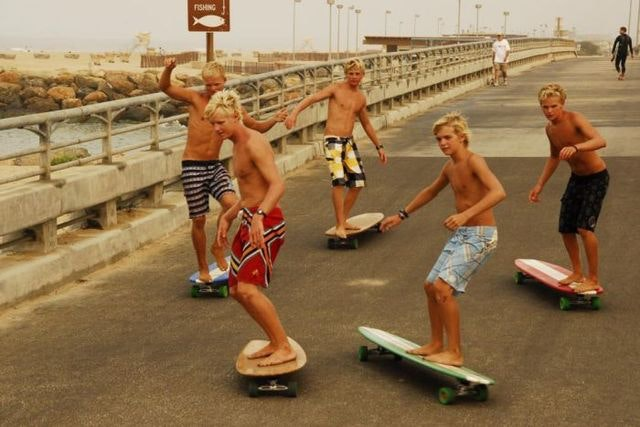WE SIDEWALK SURFERS, WE SKATEBOARD PIONEERS
SOUTHERN CALIFORNIA, SUMMER OF ‘64 — No gnarly waves, no booming breakers rolled into my hometown, 30 miles from the nearest beach. But surf was up on every sidewalk, so we gathered our tools. A 2 x 4. A roller skate. Nails, hammer, hacksaw, and the ten-year-old’s wild hair of adventure. Here was something new under the sun — skateboarding.
Saw the skate in half. Nail wheels to the board. Find a smooth sidewalk, hopefully with a hill. Name the hill after a Hawaiian beach you saw in “Ride the Wild Surf.” Spruce Street became Makaha. Magnolia was Waimea. And with a cry of “Cowabunga!” we sidewalk surfers hit the concrete.
We dreamt of freedom. We dreamt of endless summers. But our dreams were small compared to the flipping, soaring skate-dreams of today.
Skateboarding is now multi-billion dollar business, 10 million boarders worldwide. Our hammered boards have evolved into custom cool “decks” that do everything but fly. But skateboarding didn’t begin with aerial acrobatics. We pioneers just wanted to have fun.
By the 1950s, skates had rolled for centuries, scooters for decades, but it took free-wheeling California to blend them into the skateboard. No one knows who made the first model, but by the mid-50s, surfers were riding handmade boards throughout L.A.
The fun stayed local until the early ‘60s when surf movies and surf rock swept pop culture. In the summer of ‘64, Jan and Dean sang “Grab your board and go sidewalk surfin' with me.” The following summer, LIFE called skateboarding “the most exhilarating and dangerous joyriding device this side of the hot rod."
We pioneers did few tricks. With metal wheels nailed down tight, a simple turn was tricky enough. Surfer Mike Doyle remembered, “The streets were too rough for the metal wheels so we had to stick to sidewalks: downhill runs and the thrill was trying to make the corner without slipping out and having to bail out into the ivy parkway — if you were lucky enough to have ivy. I always wonder even today how we survived.”
Metal wheels rattled your feet and buzzed your brain, yet even the few commercial boards had them. We couldn’t afford a Roller Derby ($2) so how could we even dream of the first clay wheel boards — six bucks apiece! But then one of us got one and each of us rode it. Suddenly we were saving our allowances because clay wheels, smooth and quiet, could turn, weave, zip!
Eleventh birthday. First real skateboard. And we were off, all over town, making Makaha and even Waimea without a wipeout. We even slalomed through the poles at the Alpha Beta shopping center. O pioneers!
By high school, however, skateboarding seemed like junior high stuff, so most of us missed the revolution. It came in plastic. In 1972, the Cadillac Wheel Company invented urethane wheels — wheels that, as a skateboard historian recalled, “whirred like a spaceship and made you feel like you were barely in contact with the Earth’s surface.”
Then a drought left swimming pools across the Southland drained, empty. And a bunch of boarders out of the Zephyr Surf Shop in Santa Monica began hopping backyard fences to ride the sensuous cement curves of empty pools. The rest is simply scary.
We pioneers never imagined going airborne (an “ollie.”) A kickflip would have landed us on our asses. But once the Z-boy” went “vert,” the sky was the limit. Leap a curb or onto a park bench? No problem. Skate down a bannister? Got it. We Old Schoolers felt like the Wright Brothers boarding a 737. Are those boards glued to their feet? Watch:
But even if wheels were plastic, cement was hard as ever. As injuries — “a hipper” or “a swellbow” — mounted, “No Skateboarding” signs went up across America. Norway banned skateboarding altogether. In the 1980s, skateboarding became an outlaw sport. It only returned to the mainstream when skateboard parks channeled the fun onto ramps and “half pipes” safe from city streets.
Skateboard competitions had been going since the ‘60s but in 1995, ESPN debuted “Extreme Sports.” Along with BMX biking and other suicidal pursuits, skateboarding stepped into the spotlight. The light has never gone out.
Despite helmets and padding, some 125,000 skateboarders land in the E.R. each year. That hard fact, however, puts skateboarding behind the most injury-prone sports, baseball, cycling, and football. Still, if you must try this at home, wear a helmet, aka, a “brain bucket.”
This summer, the homemade sport we pioneers pushed into prominence finally hit the biggest stage — the Olympics. Twenty-five nations competed in Men’s and Women’s events, Street and Park. Japan won five medals, including three gold. The US had to settle for two bronzes. I think I know why.
Because today’s skateboarders, just like us back in those endless summers, are not out for gold or glory. “The best part of skateboarding is about style and counterculture,” said street boarder Alexis Sabiane. “And we don't play by the rules. It's like, 'I'm going to make this up and do it my own way.' That's what I love about skateboarding."
Cry Cowabunga! Now if I could just find that old board.













